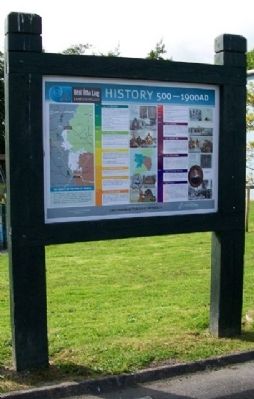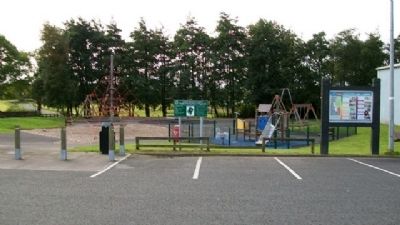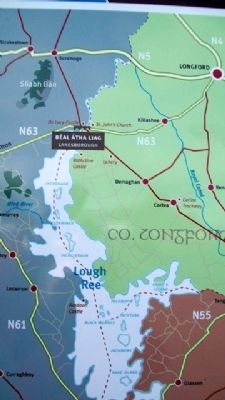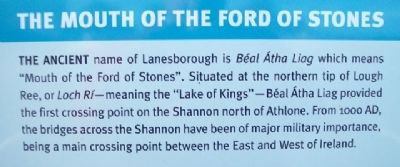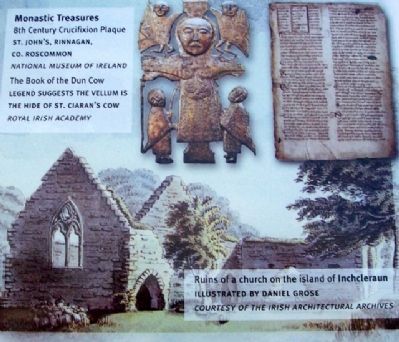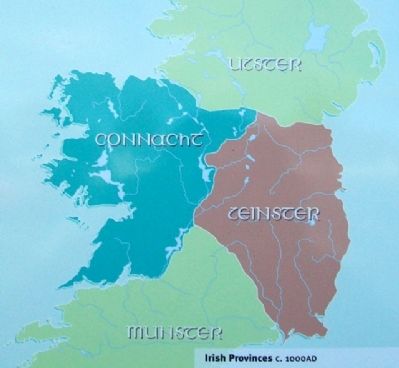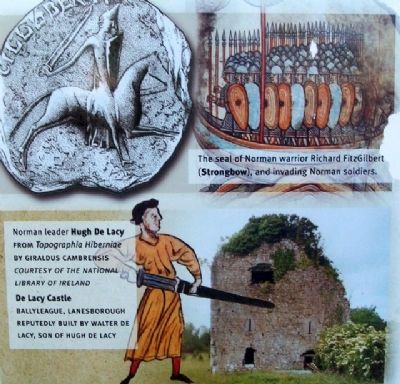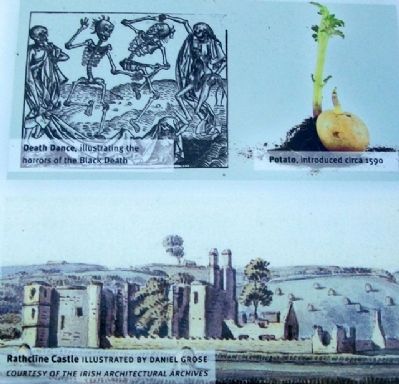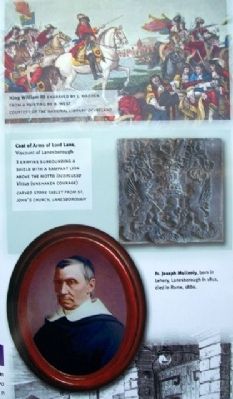Lanesborough in County Longford, Leinster, Ireland — Mid-East (and Dublin)
Lanesborough / Béal Átha Liag History 500 - 1900 AD
The Mouth of the Ford of Stones
The ancient name of Lanesborough is Béal Átha Liag which means “Mouth of the Ford of Stones”. Situated at the northern tip of Lough Ree, or Loch Rí - meaning the “Lake of Kings” - Béal Átha Liag provided the first crossing point on the Shannon north of Athlone. From 1000 AD, the bridges across the Shannon have been of major military importance, being a main crossing point between the East and West of Ireland.
540 • St. Diarmuid
As early as 540 AD, a monastery was established on Inchcleraun by Diarmuid with six churches, and other monasteries and churches followed on other islands in Lough Ree. There are still remains of some of these churches today. Diarmuid was, according to tradition, the tutor of St. Ciaran, who went on to found the monastery of Clonmacnoise further south on the Shannon.
—————
663-667 • Plague
Thousands killed by an outbreak of the plague.
—————
c.670 • St. Patrick's Day
The first mention of St. Patrick's Day (17th March) in The Life of St. Gertrude of Nivelles
—————
760 • Monastic Struggles
The Clonmacnoise and Birr Monasteries went to war.
800 • The Vikings
Béal Átha Liag has seen many battles and invasions over the centuries. The Vikings started invading Ireland from the 9th Century to the 11th Century. Its churches and monasteries were plundered and robbed several times during this period.
—————
937 • The Battle of Lough Ree
A long struggle between the Viking forces of Dublin and Limerick
1000 • First Bridge
The Viking raids prompted the first bridge to be built in the town's defence. Malachy, High King of Meath in 1000AD, started to build the first bridge from the Eastern side (now Lanesborough) in conjunction with Cathal O'Connor, King of Connacht who built from the Western side (Ballyleague) to link in the middle.
—————
1014 • The Battle of Clontarf
Brian Boru defeated the Vikings in a bloody battle in Dublin.
1140 • Turlough O'Connor
The next bridge was built in 1140 by High King of Ireland, Turlough O'Connor, in the advance of his forces from West to East.
1169 • Norman Invasion
The Norman invasion of Ireland started around 1169. The Norman invasion saw a lot of action on and around the Shannon in the Béal Átha Liag area. The Normans advanced by military strength and defended the ground captured by building castles.
1220 • De Lacy Castle
Walter de Lacy, son of Hugh De Lacy, crossed into Connacht and started building a castle on the Western bank in 1220, which was never finished – remains still stand in Ballyleague. Geoffrey Meares, built a castle on the Eastern bank of Béal Átha Liag, that was known as Meares Fort. This was to enable the Normans to maintain control of the ford crossing. Meares Fort was built where the car park stands today but no traces remain.
—————
1350 • Black Death
The Black Death arrived in Ireland where it annihilated one third of the population in the middle of the 14th Century.
—————
1446 • The Pale
The word “Pale” was first used to denote the counties around Dublin.
—————
c.1590 • First Potato
First potato was planted in Ireland by Sir Walter Raleigh, reputedly at Killua Castle in Co. Westmeath.
1664 • Lord Lane
Lord Lane was granted Rathcline Castle and most of the Rathcline lands by Charles II, King of England, in recognition of his loyalty to the Crown. Lord Lane was named after his grandfather, Captain George Lane who came to Ireland during the reign of Elizabeth I and married the daughter of Cormac O'Farrell. In 1664, Charles II granted Lord Lane a Royal Borough and this is how the Longford side of Béal Átha Liag became known as
Lanesborough
1690 • Jacobite War
Further battles were seen during the Jacobite War in 1690. Colonel Edmund O'Reilly was in charge of the defences at Lanesborough. The Williamite army under General Kirk approached the ford with the view to breaking through the defence. A cannonball, fired from the West bank, knocked down the tower of the Protestant Church built by Lord Lane. The tower was used as an observation point. The Church remained that way for nearly 200 years. The two armies fought and after losing several of his men, Colonel O'Reilly withdrew to the West bank and destroyed part of the bridge to stop Kirk crossing.
1706 • Stone Bridge
The bridge destroyed during this time was never repaired. People crossed the river by wading or by ferry when the water was high. On the morning of the fair day in Lanesborough, February 1702, the ferry carrying 46 people and their fair day goods, capsized - 35 drowned. A stone bridge was built in 1706 as a result of this tragedy. Some of the stone used was from Meares Fort built in 1228. The Lane coat of arms was carved in the bridge after the Right Hon. Lord Viscount Lanesborough who gave one hundred pounds towards the bridge.
1812 • Fr. Joseph Mullooly
Fr. Joseph Mullooly was born in Lehery to Gilbert Mullooly and Brigid Dowd. After joining the Order of Dominicans, he travelled to Rome where in 1857 he made the first of his historic discoveries - a 4th Century Basilica and 1st Century Temple in San Clemente in Rome. He died in Rome in 1880.
1847 • Famine
There have been many famines due to the loss of the potato crop - in 1739 and 1740 “entire” failure of the crops were reported. Year 1800 was another general failure. 1820 and 1821 saw complete failures in Connacht and Munster causing terrible distress in some areas. In all, 24 potato crop failures were listed by the Census of Ireland Commissioners in 1851. But despite this, none before or since have caused as much devastation and destruction as the famine of 1845 - 1851. It is estimated that 1,000,000 people died and a further 1,500,000 people emigrated. Repeated crop destruction by blight, severe winters, disease and poor Government provision caused a huge loss and had a long-reaching impact on Ireland's economic and political future.
Erected 2007 by Lanesborough Tourism Co-op Society and Shannonside Heritage.
Topics. This historical marker is listed in these topic lists: Agriculture • Bridges & Viaducts • Churches & Religion • Exploration • Forts and Castles • Settlements & Settlers • Waterways & Vessels. A significant historical date for this entry is February 12, 1702.
Location. 53° 40.374′ N, 7° 59.523′ W. Marker is in Lanesborough, Leinster, in County Longford. Marker is adjacent to the Longford County Council Playground, about 125 meters south of the Main Street (Road N63) Bridge over the River Shannon. Touch for map. Touch for directions.
Other nearby markers. At least 7 other markers are within 14 kilometers of this marker, measured as the crow flies. fáilte go Lanesborough (about 180 meters away, measured in a direct line); fáilte go Kenagh (approx. 13 kilometers away); Strokestown Brewery (approx. 13.7 kilometers away in Connacht); Mahon Dower House (approx. 13.7 kilometers away in Connacht); Dr. Dudley Forde House (approx. 13.7 kilometers away in Connacht); The Sharkey Sisters (approx. 13.8 kilometers away in Connacht); County Longford Great War Memorial (approx. 14 kilometers away).
Also see . . . Lanesborough-Ballyleague. (Submitted on February 14, 2010.)
Credits. This page was last revised on August 16, 2017. It was originally submitted on February 12, 2010, by William Fischer, Jr. of Scranton, Pennsylvania. This page has been viewed 2,776 times since then and 21 times this year. Photos: 1, 2, 3, 4, 5, 6, 7, 8, 9. submitted on February 14, 2010.
